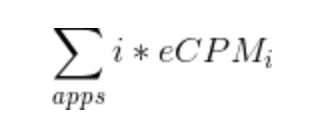Portfolio network effects (Part 3: cross promotion & monetizing)
One of the assumptions that was baked into the mathematical model in my last post on network effects is that cross promotion is done perfectly so there is no cannibalization around monetization.
Practically speaking, however, it’s impossible to avoid cannibalization in the cross promotion scenario, but you can use prediction as a tool to minimize any effects from cannibalization. Essentially the math boils down to:
Cross promote when E[Revenue from Portfolio] > E[Revenue from monetization now].
Expectation calculations boil down to your ability to predict monetization outcomes of future states.
E[Revenue from monetization now] is the easy part. Just figure out what the current eCPM for your impression is and you have an expected value for the worth of monetizing a user. In the case you use a mediation provider, you would simply request an ad from multiple networks that bid for your impression, then take the highest (or second highest) bid.
E[Revenue from Portfolio] estimation is much harder. In this case you need to predict outcomes that there is initially very little data for. You can read my introductory post on how to choose the factors in prediction for your specific use case. Multiple factors that will contribute to cross promotion include eCPM decay, retention of users in each app, and cross promotion potential for each app.
Without going too much into the math yet, companies tend to start off with experiments on monetization and iterate from there. For example, given that most ad revenue generating apps will value their first impressions the highest (given the eCPM decay curve), most developers will cross promote their users after the first impression.
This naive method of monetizing encompasses expected value expressed in the form where i is the impression (including the placement) and the eCPM is the value of that specific placement:

This accounts for the eCPM_i decay that happens within apps for a specific placement i. This means the eCPM will change based on the order of the ads shown.
Given this, you can expand prediction of ad revenue in a portfolio to setting Expected values of the factors:

In a following post we will dive into the details for calculating the expected revenue in the portfolio. This will combine the posts on prediction and on portfolio network effects.